Dora Wahlroos
Anna Dorothée (Dora) Wahlroos (19 December 1870 Pori – 21 March 1947 Kauniainen) was a Finnish painter who participated in the painting movement en plein air towards the end of the 19th century.[1][2][3]
Dora Wahlroos | |
|---|---|
.jpg) Self-Portrait, 1901 | |
| Born | Anna Dorothée Wahlroos 19 December 1870 |
| Died | 21 March 1947 (aged 76) Kauniainen, Finland |
| Nationality | Finnish |
| Known for | Painting |
| Movement | en plein air |
Biography
She was born in Pori to province land surveyor Johan Henrik Wahlroos and Dorothée Augusta Henrietta Fehn.[1] She studied at the Turku Drawing School in 1886–1888 and under Victor Westerholm in 1889–1890. She was one of the artists who joined Westerholm in the artists colony at Önningeby on the island of Åland.[1][4][5]
She was accepted to the Finnish Art Society in 1890–1891, where her class was taught by Gunnar Berndtson. In the Fall of 1890 she got engaged to sculptor Emil Wikström. The two went to study together at Paris in 1891–1892.[1] She won third prize in a competition with By the wash basin in 1893 and the same year she was granted a stipend. In Spring 1895 she was back at Paris and completed Inspiration there.[1] However by this point she had separated with Wikström, who married her friend Alice Högström in 1895.[1] In the late 1890s she painted a number of paintings of local Finnish sceneries and she also did altar paintings.
In August 1900 she traveled to Paris for the 1900 Paris Expedition, and from there she headed to the village of Antignano in Livorno, Italy, where Elin Danielson-Gambogi was living with her husband Raffaello Gambogi. It turned into a slight misadventure for her as Raffaello fell deeply in love with her. She returned to Finland and sent back the letters he had sent unopened.[1] She became less outward after this, spending more time with her family first in Turku and then in Kauniainen, where they bought a villa.[1] Still, her use of color changed after the trip, becoming more vibrant. She is known to have admired to strong use of color by Raffaello.[1]
She studied more at München in 1911.[1] Although she painted her entire life even until the end, her later works didn't get as much recognition. She died in 1947 from complications following an accident.[1]
Works
 Self-Portrait, 1889
Self-Portrait, 1889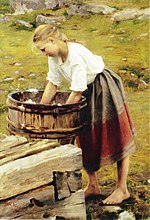 By the wash basin, 1892
By the wash basin, 1892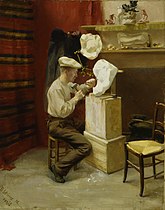 Emil Wikström in His Studio in Paris, 1892
Emil Wikström in His Studio in Paris, 1892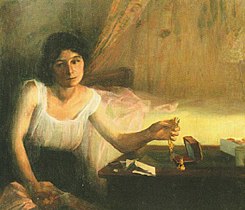 Longing, 1892
Longing, 1892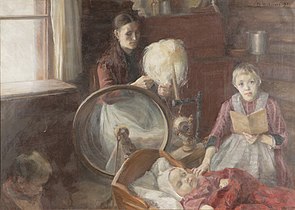 Mother and Children, 1894
Mother and Children, 1894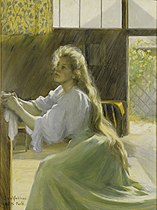 Inspiration, 1895, self-portrait
Inspiration, 1895, self-portrait.jpg) Evening at Parainen, 1898
Evening at Parainen, 1898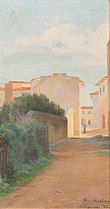 Motif from Italy
Motif from Italy- Portrait of Reinhold Hausen, 1913
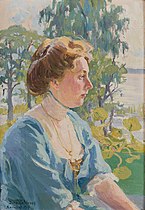 Portrait of a Lady, 1913
Portrait of a Lady, 1913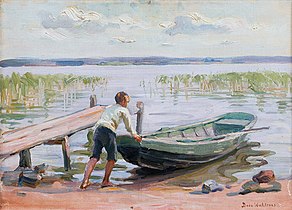 A Boy and a Boat by the Shore
A Boy and a Boat by the Shore.jpg) Self-Portrait, 1943
Self-Portrait, 1943
See also
- Golden Age of Finnish Art
- Art in Finland
References
- Konttinen, Riitta (1 March 1998). "Wahlroos, Dora (1870 - 1947)". Kansallisbiografia. Retrieved 18 May 2020.
- "Dora Wahlroos – kultakauden unohdettu lahjakkuus". Naisten Ääni. Retrieved 18 May 2020.
- Sundell, Dan (7 March 2008). "En obemärkt målarinna ställs ut" (in Swedish). HBL.fi. Retrieved 28 March 2017.
- "Unohdettu Dora Wahlroos". Helsingin Sanomat. 19 December 2019. Retrieved 18 May 2020.
- "Önningebykolonin - en bortglömd konstnärsgemenskap från landskapsmåleriets guldålder" (in Swedish). Tidskriften Skärgård, Årgång 24 Nr 4. 2001. Retrieved 28 March 2017.